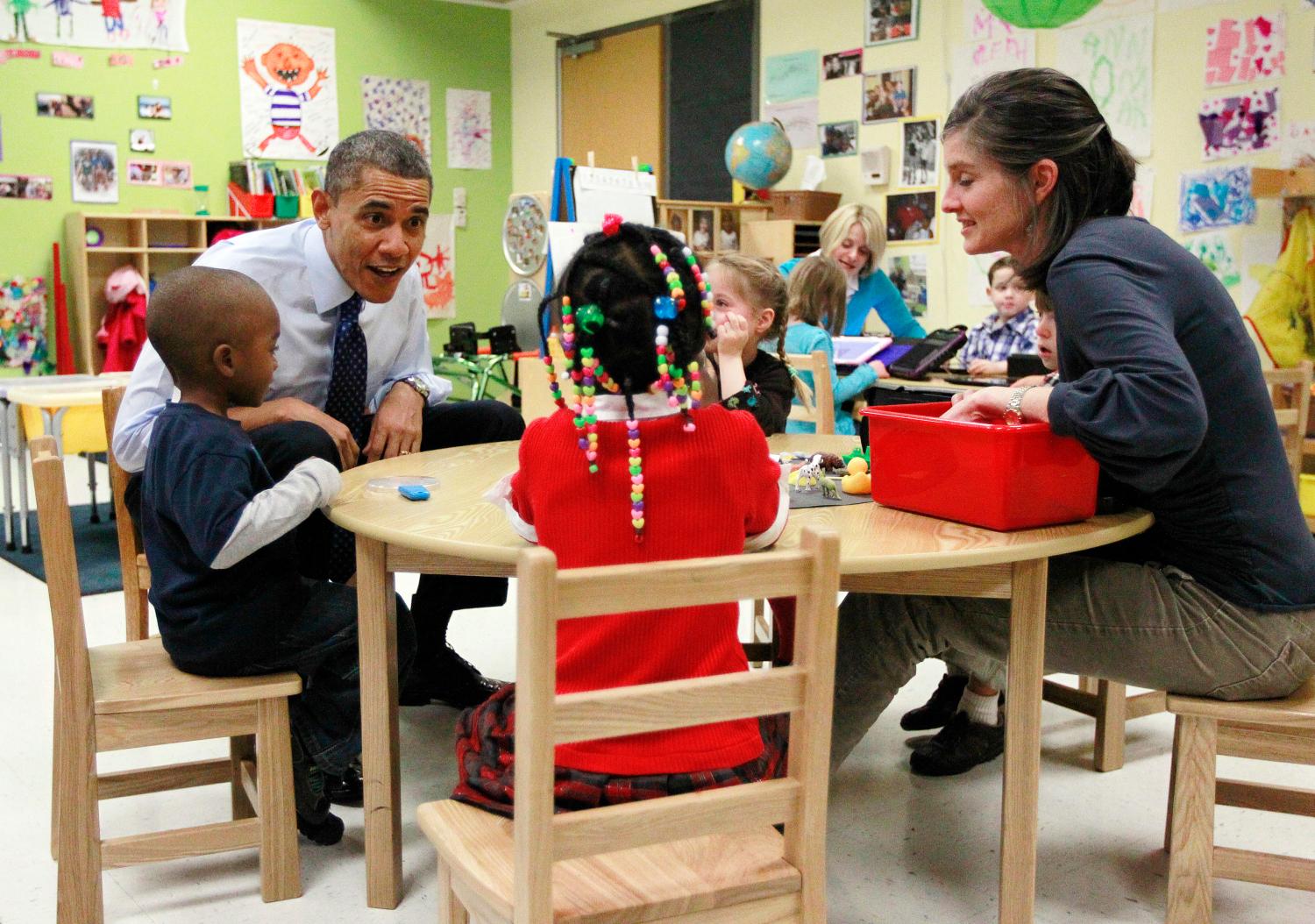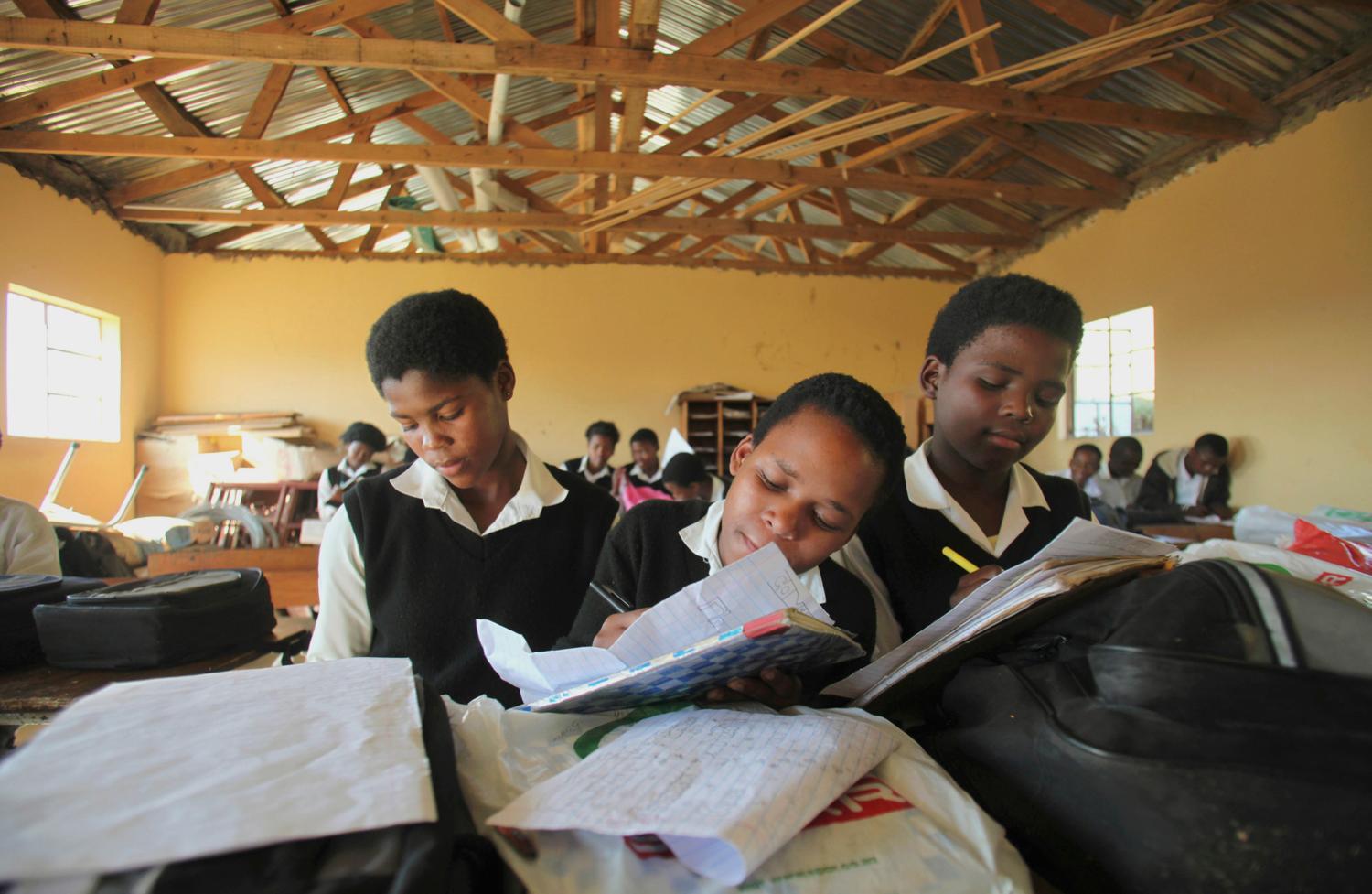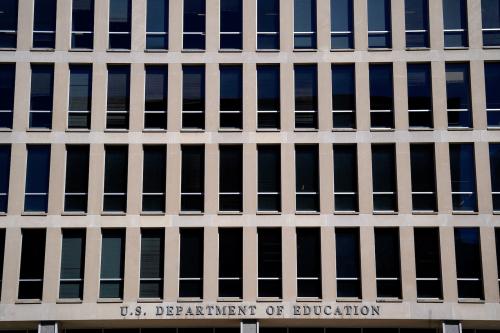When I began writing reports on preschool a month ago, first with a piece on Head Start and then another on Universal Pre-K, I had an inkling that the Obama administration was considering initiatives in this area. I had no idea that preschool policy would be a centerpiece of the president’s state of the union address. I’ve been popular since. Thank you, Mr. President, for drawing attention to my work, no matter how inadvertently.
The president’s preschool plan deserves serious consideration and analysis, and I’ll attempt that here. But the plan I’ll address is the one described in the fact sheet released by the White House, not the one the president has been talking about. In his state of the union address the president said, “I propose working with states to make high-quality preschool available to every child in America” [emphasis added here and in the next two quotes]. Two days later at a preschool in Decatur, Georgia, he repeated that call, “Let’s make it a national priority to give every child access to a high-quality early education.” And he added a populist appeal to middle class parents, “Michelle and I remember how tough it can be to find good childcare. I remember how expensive it can be, too.” He singled out Georgia and Oklahoma for praise because they “have worked to make a preschool slot available for nearly every parent.”
Bait-and-switch. I’m sure there are a lot of parents who can resonate to the new entitlement the president seems to be offering: taxpayer-funded preschool for all. But whereas the president has been selling his preschool plan to the middle-class parents as universal, i.e., available to them, the White House fact sheet makes it clear that the administration is proposing to work with states to fund expansion of taxpayer-funded pre-K for lower income families. Specifically, the administration’s plan is to share the costs with states that are willing to expand public preschool to reach all four-year olds from families at or below 200% of the poverty line[1] and that expand their half-day kindergarten programs to full day for the same families. So let’s be clear, the president’s plan may have the effect of expanding the middle-class in the future to the extent that early education enhances school readiness and improves the chances for upward mobility of children reared in low income families. But he is not proposing federal funding of public pre-K for the current middle class even though that is what you might think from listening to him. In fact, the Obama administration’s preschool plan is consistent with the federal role in education and human services since the Lyndon Johnson administration: targeted assistance for services to the economically disadvantaged.
Once we get beyond the president’s rhetoric to his actual plan, there are several things I applaud, particularly if I’m allowed to read between the lines.
- Targeting. I’ve previously described evidence that suggests a much greater return on public investment for targeted pre-K as compared to universal pre-K, so the administration’s focus on providing financial support for expansion of pre-K access for 4-year-olds from lower income families is consistent with the evidence on both where the need exists for enhancing children’s school readiness and on how to maximize bang for the buck.
- Data and assessment systems. If we have learned anything from more than a decade of rigorous research on K-12 public education it is that quality varies widely by classroom and school. For instance, variations in classroom quality in kindergarten are significantly related to college attendance rates and labor market earnings.[2] Although the research is not as causally rigorous, we also have evidence that variation in the quality of adult-child interactions in child care settings for preschoolers is associated with differences in cognitive/academic development that persist at least through adolescence.[3] If we don’t collect data and carry out assessments that yield information on the quality of the out-of-home settings in which young children are being cared for, neither states, the federal government, nor more importantly parents will be able to take the actions that are necessary to avoid low-quality services. It remains to be seen what types of data and assessment systems the Obama administration has in mind. It will be important to include observational measures of classroom interactions, assessments of child outcomes (yes, 4-year-olds can be tested without stress to them and with reliable results), and surveys of parental satisfaction.
- Curriculum. There is good evidence that children’s pre-academic skills including vocabulary, letter recognition, and phonemic awareness are strongly associated with academic outcomes during elementary school and that children from low-income families are far behind their more economically advantaged peers on these skills at school entry.[4] There is also strong evidence that the curriculum used in classrooms for 4-year-olds from low-income families has a significant impact on the development of these pre-academic skills.[5] Thus, the administration’s commitment to linking federal funding to the requirement that preschool programs have a “rigorous curriculum” is important and evidence-based.
- Curtains for Head Start (as we know it). A casual reader of the administration’s preschool fact sheet might think that Head Start is a winner. After all, there is a bulleted, bolded heading: “Under the President’s proposal, investment in the federal Head Start program will continue to grow”. But a closer reading suggests that the administration’s plan to support the expansion of state pre-K programs for 4-year-olds will be at the expense of Head Start, which serves the same population. The administration’s plan is to expand Head Start services for children from birth to age 3, and to do this through a “partnership program” with states and communities. Traditional Head Start is not administered in a partnership with states and communities, does not serve children from birth to three, and it does not work in terms of getting low-income children ready for school. The administration knows that Head Start isn’t getting the job done and is proposing a bold move in a new direction. Hurray if they can push this through in the face of what will likely be fierce opposition from the Head Start lobby.
Nothing is perfect – and certainly not the president’s preschool plan. Areas in which the administration has it wrong or has left out something very important include:
- Teacher credentials and pay. The president proposes that all states would staff their pre-K programs have “well-trained teachers, who are paid comparably to K-12 staff”. There is no way politically to pay pre-K teachers on the same scale as K-12 teachers unless they have comparable credentials, so what the president is really proposing is that pre-K teachers be required to have a 4-year college degree and jump through the same credentialing hoops as K-12 teachers. But we know that the degree and the traditional requirements for being credentialed as a teacher have little or nothing to do with the quality of interactions in preschool classrooms.[6] Neither does teacher salaries.[7] Thus requiring states to credential and pay pre-K teachers as they credential and pay K-12 teachers assures only two things: high costs and supportive teacher unions.
- Local school districts in charge. Under the administration’s plan federal dollars would flow to states based on their share of four-year olds from lower income families and “funds would be distributed to local school districts and other partner providers”. We’ll have to wait and see what “other partner providers” means, but my reading is that the intent of the president’s proposal is that money would flow to states and that states would fund school districts to expand their school-based programs downward in age to include pre-K for 4-year-olds. In far too many cases these would be the same school districts that are responsible for the terrible public schools that will fail to educate the very children the president’s preschool proposal is intended to benefit. Further, research shows no association between the quality of classroom interactions and whether a classroom is physically part of a public school, although teachers in classrooms within public schools are predictably paid more.[8] When combined with the administration’s proposals on teacher credentials and pay, this looks like a policy designed to appeal to those who benefit from the status quo in American public education. I would urge an administration that clearly understands the value of charter schools in breaking up the monopoly of failing traditional public schools to think again about a plan for preschool that would make school districts the principal or sole provider of federally subsidized pre-K services.
- Choice. The administration’s plan is silent on whether and how parents will be able to exercise choice in where they send their child to pre-K. Choice is important for many reasons, including its importance to parents, who are used to exercising it for preschool. It also impacts program performance and innovation because it allows for variety in programs and competition among providers. There are also equity issues in that it is typically the poorest parents who can’t escape the destiny of their zip code when it comes to their children’s schooling. This is as true of state pre-K as it is of K-12: classrooms that serve children from the most disadvantaged homes have less experienced teachers and lower quality instruction than classrooms that serve more advantaged students.[9] The only way to prevent this is to give parents the right to vote with their feet and send their child to the preschool they prefer rather than the preschool to which they are assigned. The nation is likely to see much better outcomes over the long term if the federal government provides significant incentives for states that accept the federal pre-K subsidy to allow a variety of organizations to provide pre-K programs and permit parents to choose among them. The requirements for data, assessment, and program evaluation that are part of the administration’s plan should enable parents to shop wisely if that information is made available to them, and allow state-level program overseers to disqualify weak providers from participating in the program.
- Lack of integration with other federal funding streams. The federal government funds many programs that are intended to improve the education of young children. Among the largest are Head Start, the Child Care and Development Fund, Temporary Assistance for Needy Families, Title I of the Elementary and Secondary Education Act (which permits expenditures on pre-K programs), and Individuals with Disabilities Education Act programs for infants and toddlers as well as preschoolers. There is 15 to 20 billion dollars in annual expenditure on early education through these programs. This is more than the federal government spends through Title I, Part A of the Elementary and Secondary Education Act to support the education of the disadvantaged in all of K-12. At the very least, the administration should push for common data, assessment, and program evaluation approaches, and a unified system for providing information to parents on center quality across these funding streams. A bolder direction would be to combine these funds into a single state block grant to support the early education of vulnerable young children.
- Do no harm. Some children need publicly supported out-of-home care to be prepared for school and life. But the supposition that all children need or benefit from these services is not supported by research. For example, the federal Child Care and Development Fund, which provides relatively low levels of financial subsidy to young mothers on welfare to purchase formal child care when they obtain employment, appears to negatively impact the academic outcomes of the children of participating mothers.[10] The provision of universal child care services in one province of Canada appears to have encouraged mothers who would otherwise have cared for their children at home to move those children into organized child care settings, again with negative impacts on child outcomes.[11] Further, a large body of research demonstrates negative relationships between hours spent in non-relative care during early childhood and undesirable social outcomes. For instance, adolescents who experience more hours of non-relative child care across their first 4½ years report significantly more risk taking and impulsivity at age 15.[12] It is important for policy makers, include those in the Obama administration, to be mindful that not every preschool-aged child needs to be in an organized preschool setting to be ready for school and that there are risks for some young children in spending considerable time away from their parents in those settings.
Research on small scale high intensity programs such as Perry and Abecedarian has shown us the great potential of early education to improve the lives of children, whereas research on contemporary large scale pre-K interventions, including Head Start and the Georgia universal pre-K program, has introduced a needed dose of realism into expectations for what publicly funded pre-K programs can achieve. There is no question that gaps in school readiness between children from advantaged vs. at-risk backgrounds are far too large and need to be reduced if the nation is to achieve the education excellence it needs to serve its citizens and to compete in the world economy. If the Obama administration is willing to offer a preschool plan that keeps parents in the driver’s seat in terms of choosing where to send their child, puts states in charge of administering the program and provides them with general guidelines rather than detailed prescriptions, and redirects existing resources rather than calling for large new expenditures there is a significant possibility of bipartisan support in Congress. This is an exciting time for preschool education.
[1] The 2013 federal poverty line for a household of three people living in the contiguous 48 states is $19,530.
[2] http://obs.rc.fas.harvard.edu/chetty/STAR.pdf
[3] http://www.ncbi.nlm.nih.gov/pmc/articles/PMC2938040/
[4] http://lincs.ed.gov/publications/pdf/NELPReport09.pdf
[5] http://ies.ed.gov/ncer/pubs/20082009/pdf/20082009_rev.pdf
[6] http://psycnet.apa.org/psycinfo/2007-02875-002
[7] http://www.leg.state.vt.us/PreKEducationStudyCommittee/Documents/impact%20of%20teacher%20and%20classroom%20quality.pdf
[8] Ibid
[9] Ibid
[10] http://www.chrisherbst.net/files/Download/C._Herbst_Subsidies_Child_Development.pdf
[11] http://www.nber.org/papers/w18785
[12] http://nieer.org/pdf/Effects_of_Early_Child_Care_Extend_to_Age_15.pdf
The Brookings Institution is committed to quality, independence, and impact.
We are supported by a diverse array of funders. In line with our values and policies, each Brookings publication represents the sole views of its author(s).





